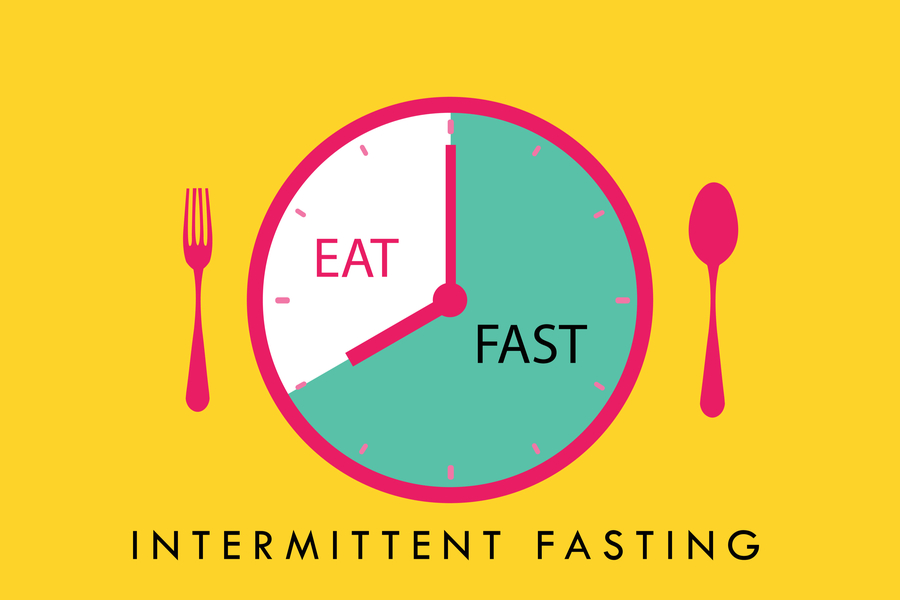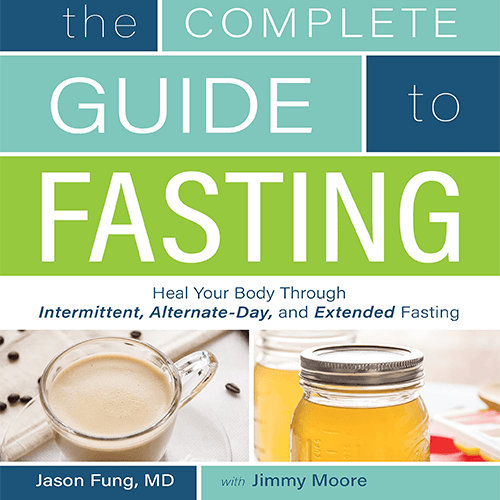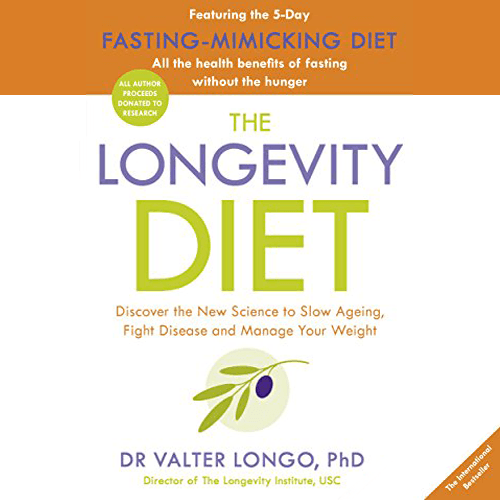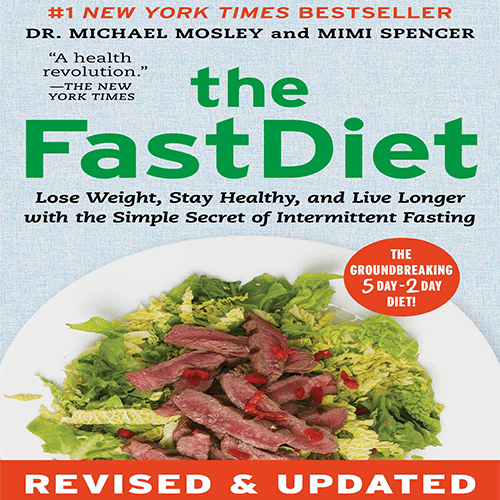Intermittent Fasting 101 - Beginners Guide
Written by Andrew Brewer. ⚕️Reviewed and fact checked by Dr. Harshi Dhingra & Melissa Mitri, Ms, Rd.
As one of the world’s fastest-growing dietary trends, intermittent fasting has taken the web by storm. Everyone seems to be talking about it now. Whether it be partaking in intermittent fasting or discussing the credibility of the practice, it’s become quite a popular subject.
But what is intermittent fasting? What does it offer and why is everyone so interested in it?
Intermittent fasting can be an interesting topic to dive into, but it’s easy to get lost while learning about it. There is so much information readily accessible on intermittent fasting that beginners can have a tough time getting started. To help people truly understand intermittent fasting and everything it offers, we’ve created this comprehensive guide to this dietary phenom.
In this beginner’s guide to intermittent fasting, we’ll be taking a look at everything there is to know about the topic. From basics like what intermittent fasting is to more complex topics like how to know if it’s right for you - we got you covered.
Intermittent fasting can be a beast to tackle, but with the right guide and a wealth of information, it can become much more accessible to all.
Key Takeaways
- Intermittent fasting has several health benefits, including weight loss, improved heart health, reduced risk of certain cancers, and better mental wellness.
- Intermittent fasting works by restricting food intake to specific periods, with several methods available to suit different lifestyles.
- Common intermittent fasting side effects include headaches, fatigue, mood changes, dehydration, and malnutrition, which can be mitigated with careful planning and a gradual transition into and out of fasting periods.
- It is important to find the right intermittent fasting method for your individual needs, seek assistance if needed, and prioritize overall health and well-being during the process.
- While there is much correlating data on the benefits of intermittent fasting, more research is needed to establish concrete connections between intermittent fasting and certain health outcomes.
What is Intermittent Fasting?
Let’s start at the very beginning - what is intermittent fasting? If you’re ever looking to lose weight fast while remaining healthy and allowing yourself to keep a similar diet to what you had already, then intermittent fasting is the perfect tool for you. Intermittent fasting is a dietary cycle where the user will designate times throughout the day/week as far as when they eat and when they fast.
Essentially, you’re breaking down your schedule into periods of eating and fasting. There are a few different intermittent fasting methods that we will take a closer look at.
Some intermittent fasting methods are practiced daily, where your day is divided into periods of fasting and eating. Others require you to pick specific days of the week for fasting while keeping the rest as normal eating days.
The main idea of intermittent fasting is to emphasize when you eat rather than what you eat. Many experts and influencers alike pitch intermittent fasting as the weight loss plan that allows you to eat whatever you want. There is some truth to this, but within reason.
Intermittent fasting works so long as you stick to your fasting schedule AND take care of your body in the process.
That’s what makes intermittent fasting different from your standard diets: you’re not limiting what you put into your body, you’re just focusing on when you do so.
If you want to learn more about it, we would like to recommend you reading intermittent fasting books that deep dive into the topic and explain everything very carefully.
Best Intermittent Fasting Sources
Difference Between Intermittent Fasting and Regular Fasting
There is one major difference between intermittent fasting and your typical fasting - timing. With intermittent fasting, the point is to keep to a schedule and to do it regularly.
Fasting, on the other hand, can be random or even prolonged. Certain types of fasting require the body to fast for a much longer period (2-3 days at a time.) With intermittent fasting, that time is greatly decreased. You’re only fasting for hours at a time rather than days, which can be much more sustainable.
Regular fasting can be quite demanding on the body as it’s often prolonged and not always part of a schedule. While it is a way to lose weight, it does take a mental toll on the user.
With intermittent fasting, however, mental health and simplicity are key. You shouldn’t have to torture yourself to lose weight.
For some, fasting is a religious experience and is done as part of a holiday or festival. Intermittent fasting is merely a weight loss plan and has no religious context. There is a history to intermittent fasting, but it has always had its roots in the health and fitness community.
Though they are similar in nature - including periods where you do not eat and limit what you drink - there are many differences between intermittent and regular fasting.
Is Intermittent Fasting Healthy?
A weight loss plan that is super effective and doesn’t require you to count calories or eat on a meal plan? There’s no way that works as well as people are saying while keeping you truly healthy, right?
That’s what makes intermittent fasting so popular! It truly does work and it keeps you healthy while partaking in it. The goal of intermittent fasting is to help you lose weight fast and in a safe and healthy manner. If you’re losing weight but your body isn’t responding well your fasting schedule,then you need to adjust the level at which you’re fasting.
Intermittent fasting is healthy because you’re still receiving the necessary amount of calories for your body to properly function, you’re just doing it in a smaller window. In many cases, intermittent fasting is a natural way for your body to process all of the calories and nutrients received from eating throughout the day, as there is now a wider window of time for it fully digest and operate.
According to some studies, intermittent fasting could even be healthier for the body than a normal diet. Some studies point to a longer lifespan when the body has been regularly intermittent fasting.
In reality, humans have been fasting in some way for centuries, especially when the food supply was scarce, so our bodies are attuned to it. Intermittent fasting is a healthy and safe way to lose weight fast.
What Are the Benefits of Intermittent Fasting
Let’s take a look at what makes intermittent fasting so appealing. Here are some of the biggest benefits you can experience when you begin intermittent fasting. Some of these benefits are based on studies that have spotted a correlation between the results seen and intermittent fasting.
Weight Loss
This is why most people begin intermittent fasting. It’s one of the most powerful weight loss tools available. If you’re dedicated and take the process seriously, then you could find yourself losing weight easily.
The span of fasting allows your body more time to process the food and handle all of the calories you’ve put into it. Intermittent fasting helps you to eat fewer calories while burning more during the fasting window.
Most users have reported a 3-8% weight loss by the first 3 weeks. Some users found the weight loss took a little bit longer, but reported a majority of the weight loss was from the waist circumference.
Intermittent fasting is a fantastic way to burn calories fast and lose that extra weight fast. It helps you eat less throughout the day naturally, while burning more calories during the fasting period.
Healthy Heart
Certain risk factors can build up over time in our bodies that could lead to heart disease and heart attacks. Intermittent fasting can help the body prevent these risk factors and lowers the risk of serious heart damage. In fact, some studies have found a correlation between intermittent fasting and lower levels of cholesterol in the body.
While there is no concrete connection as of yet between heart health and intermittent fasting, there is an overwhelming wealth of correlating data that points to a connection. Intermittent fasting may also reduce blood sugar and insulin resistance levels, which helps keep your heart healthy as well.
Cancer Reduction
As with heart health, there is no concrete connection between cancer reduction and intermittent fasting. However, many studies have pointed out a hard correlation between the two. Intermittent fasting may have a massive hand in reducing the risk of and preventing certain types of cancers, which may be due to a process that occurs during fasting called autophagy.
Autophagy is a process that occurs in the body to rid itself of damaged or unhealthy cells. During periods of fasting, there is a longer opportunity for this process to occur.. When your body has the time to process certain foods and better health is promoted, serious diseases such as cancer will have a harder time taking root.
Mental Wellness
Besides weight loss, this is the main reason why people look into intermittent fasting. It’s a great way to improve your mental health and promote a better lifestyle. When you take care of your body, your body takes care of you. Intermittent fasting has been proven to improve sleep, reduce restlessness, and increase certain growth hormones in your brain involved in mental health.
These growth hormones help improve your well-being and keep you healthy. Along with a better mental state, there has also been some correlation between intermittent fasting and a decreased risk of Alzheimer’s disease.
START YOUR INTERMITTENT FASTING JOURNEY TODAY
Are you looking for the best way to start intermittent fasting? If yes, we would like to recommend a program that will make everything super easy!
Different Types of Intermittent Fasting
There are several different types of intermittent fasting. The array of options allows you to customize your plan and fit your periods of intermittent fasting into your schedule. You should have control over your intermittent fasting, not the other way around. Some of these intermittent fasting methods can be quite demanding, so experts recommend beginners start with a lower level of fasting.
Let’s take a look at some of the most popular intermittent fasting plans out there. These are the intermittent fasting methods that you’re likely to encounter online. They’re the ones that are either most commonly used or the most effective for quick weight loss.
-
16:8
The 16:8 is a daily intermittent fasting plan and is easily the most popular one out there. It’s a ratio of when to fast and when to eat throughout the day. It breaks the day down into two sections: 16-hours of fasting, and 8-hours of eating. The 16:8 is one of the most popular intermittent fasting plans because it’s accessible and easy to get started with.
16 hours of fasting can sound intimidating, but it’s actually quite approachable for beginners. Most people who partake in the 16:8 orient it so that they skip breakfast, start eating around noon, and finish up their day with an 8 pm snack. This way, you’re still getting two meals and a few snacks throughout the day but you’re adhering to the schedule.
The 16:8 method isn’t as demanding as other daily intermittent fasting plans and is a fantastic starting point for beginners. If you’re looking to get started with intermittent fasting, it’s recommended that you try out the 16:8 method first to see how your body reacts to it. If you want to increase the levels of fasting, then do so slowly and with the needs of your body.
Choose an eating window that works best for your schedule, but do know that it may be most beneficial for your health to follow an earlier eating window, such as 7am-3pm, versus noon-8pm.
-
20:4
Much like the 16:8, the 20:4 is a daily intermittent fasting method that breaks the day into segments of eating and fasting. This plan is a bit more rigorous than the 16:8, as it only allows for 4 hours of eating each day. With the 20:4, you have 20 hours of fasting that must be completed each day. This can seem quite daunting, but most users have worked their way up to this level of fasting.
One of the most common orientations of this method of intermittent fasting is two major meals and a snack in between. Start your eating window off with a late lunch, have a snack, and then finish it up with dinner. This helps your body receive the calories it needs to function without stuffing yourself and shocking your system.
It can be difficult to get used to a shorter eating window, but once it’s become part of your daily schedule, you’ll find that it’s much easier than it seems.
With that said, I do not recommend starting with the 20:4 intermittent fasting method if you’re a beginner. Work your way up to it and then it’ll be much more accessible for your system.
-
22:2
This is one of the most demanding forms of intermittent fasting. It’s designed as a daily fasting method, much like the ones listed above, but you might want to schedule some days off. The 22:2 splits your day into segments of eating and fasting. The 22 refers to the 22 hours of fasting that occur each day and the 2 refers to your eating window.
22 hours of fasting is incredibly difficult, especially for beginners. Do not start out with the 22:2, no matter how quickly you want to lose weight. It can be damaging for your body if you’re not trained in intermittent fasting. Shocking your system is a horrible way to lose weight and a great way to damage yourself.
With that being said, once you’re ready for the 22:2, it can be an effective way to lose weight fast. The success of the 22:2 all depends on that 2-hour window of eating. You will need to be very strategic on what you eat throughout that period as it will affect the effectiveness of your fast. Plan your meals and make the most out of your limited eating time.
-
Eat-Stop-Eat
The Eat-Stop-Eat intermittent fasting method is where you go a full 24-hours of fasting twice a week. The two days of the week in which you fast must be on non-consecutive days. Otherwise, you could be doing some serious damage to your system. For the remaining 5 days of the week, you eat normally and don’t have to limit yourself as to when you eat.
One of the most common ways to partake in the Eat-Stop-Eat method is to begin your window of fasting after dinner and continue it throughout the next day. That way, you begin your fast at the end of the day, allowing for sleep to take up most of the fasting window. You’ll also have a full stomach when the fasting begins.
The Eat-Stop-Eat method can be quite demanding on the body, so it’s recommended that you take it slowly. Fasting for a full 24-hours requires a lot of stamina and mental fortitude. You could find yourself craving something in particular which will make the whole process much more difficult. Listen to your body to determine the best schedule for you.
-
5:2
The 5:2 method is very similar to the Eat-Stop-Eat method in that you select two non-consecutive days throughout the week for fasting. The difference between these two methods is that instead of completely withholding food for a full 24-hours, the 5:2 method requires you to eat no more than 500 calories on the specified days.
5:2 breaks the week down into 5 days of eating normally and 2 days of limited eating. This might be the easier version of the Eat-Stop-Eat and often acts as a stepping stone for beginners.
Eating around 500 calories a day for two days can still be quite difficult, sometimes more so than fasting for a full 24 hours. By simply not eating at all such as in the eat-stop-eat method, your body sometimes reverts into a state of acceptance.
Eating only 500 calories can convince your body more food is coming, which makes hunger harder.
Side Effects of Intermittent Fasting
Here are some of the most common intermittent fasting side effects. Many of these can occur when you’re first starting out and will likely resolve themselves in a few weeks, as your body gets used to the new normal. Some of them, however, could be signs that you need to change your intermittent fasting plan, especially if they don’t go away in the first few weeks.
-
Headaches
These are most common when you’re just starting out with intermittent fasting. They’re likely due to low blood sugar and caffeine withdrawal.
-
Fatigue
Sometimes fatigue can set in as your body adjusts to the new normal that is intermittent fasting. A new diet can sometimes cause your body to tire out as it has less energy from less food.
-
Mood Changes
Whenever you eat less food, there is a chance that you’ll get hangry. It’s a natural part of dieting and one that can easily set in when you’re intermittent fasting. This will slowly fade as your body gets used to intermittent fasting.
-
Dehydration
As intermittent fasting just gets started, your body will likely be releasing more water through urine than normal. This can lead to dehydration if you’re not careful, so be sure to supplement your fasting with low-calorie drinks like water and tea.
-
Malnutrition
There is always a risk of nutrition deficiencies with intermittent fasting if you’re not careful. If you go through your fasting period and then don’t replenish the necessary amount of nutrients when eating, you can very quickly become malnourished. Be careful when intermittent fasting and ensure that you take care of your body throughout the process.
Easing In and Out of Fasting
One of the most important parts of any intermittent fast is the transitional phase. When you go from fasting to eating again, you have to take care of your body, especially with the more demanding intermittent fasting methods. If you go from fasting for hours on end to eating a massive meal right away, you could shock your system.
It’s important that you wake your system and break your fast with gentle foods and easy calories. When first starting out your eating window, most experts recommend healthy fats like yogurt or eggs.
These foods are easy on the system and prevent you from shocking yourself once your fast ends. It can be tempting to stuff yourself to fill your hunger, but this will only lead to issues down the road.
The same importance can be placed on easing your way into the fasting window. You don’t want to enter your fasting time stuffed to the brim with food, but you also don’t want to go in already hungry.
It’s important to also find that balance when you finish up eating for the day. Ending with a small snack to calm your stomach but not overdo it is preferable.
This is what makes the 16:8 the easiest intermittent fasting method to partake in. It has a built-in window that allows for that gentle evening snack to be the final thing you eat before your fasting window begins. Most other intermittent fasting plans place dinner as the last meal of the day, so balancing the transition into fasting can be more difficult.
Finding the Right Intermittent Fasting Option For You
There are so many intermittent fasting methods around that you’ll never run out of choices. It’s important to find the perfect one for you, as what might work for the masses won’t necessarily work for you.
Play around with your intermittent fasting methods and choose one that feels right. If the 16:8 isn’t showing enough results but the 22:2 is taking a toll on your body, try out the 20:4 or the 18:6! The only hard rule to intermittent fasting is that you stay healthy and feel your best while practicing it.
Don’t be afraid to seek out assistance - there are countless apps and programs out there who are ready and able to help you through the process. Intermittent fasting is best done with someone by your side helping you through it all. Find the right program and the best option to make your intermittent fasting experience a success! Bellow you can find some of the best intermittent fasting apps in the market.
FAQ
 How should a beginner start intermittent fasting?
How should a beginner start intermittent fasting?
If you're new to intermittent fasting, it's best to start slow and work your way up. You can begin with the 16:8 method, which is the most popular and easiest to start with. This involves fasting for 16 hours a day and eating within an 8-hour window. It's also important to choose an eating window that works best for your schedule and to ease in and out of fasting with gentle foods. It's recommended to seek out assistance from apps or programs to help you through the process.
 How long should beginners do intermittent fasting?
How long should beginners do intermittent fasting?
The duration of intermittent fasting depends on your goals and personal preferences. As a beginner, it's best to start with a shorter fasting period, such as 16 hours, and work your way up to longer periods like 20 or 22 hours. It's important to listen to your body and to adjust your fasting schedule accordingly. It's also recommended to consult with a healthcare professional before starting intermittent fasting, especially if you have any underlying health conditions.
Written By Andrew Brewer
Andrew Brewer started FastingApps to give people the guidance that he never received when he was first starting. His goal is to make your goals achievable and to offer you only the best fasting apps that the internet has to offer. You're not on your own - Andrew and the entire family of reviewers at FastingApps are here with you every step of the way!










 How should a beginner start intermittent fasting?
How should a beginner start intermittent fasting?